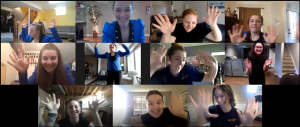 As a student occupational therapist, one of the main concepts that have been instilled in me is the profound impact that engaging in meaningful activities has on one’s health and wellbeing. When you break down this idea, it truly does make sense as our lives are made up of doing things we like, or need to do, on a daily basis. Quite simply, if we have opportunities to engage in activities we enjoy doing, our physical and mental health will reap the benefits.
As a student occupational therapist, one of the main concepts that have been instilled in me is the profound impact that engaging in meaningful activities has on one’s health and wellbeing. When you break down this idea, it truly does make sense as our lives are made up of doing things we like, or need to do, on a daily basis. Quite simply, if we have opportunities to engage in activities we enjoy doing, our physical and mental health will reap the benefits.
As the Dance Ability Movement was founded by occupational therapists, it only makes sense that their philosophy directly reflects this idea. Through engaging in dance, individuals of all abilities can experience the joy of this meaningful activity. Likewise, through the class structure, dancers enrolled at the Dance Ability Movement, also experience the opportunity to become a part of a community, to belong, and to feel connected to one another; which during a pandemic is needed now more than ever.
While the pandemic has had significant negative repercussions for society as a whole, if you look at it from a different point of view, it has also allowed individuals to indirectly understand a fundamental principle of occupational therapy. Most people have been stripped of engaging in meaningful everyday activities and their usual routines and subsequently have felt the loss associated with no longer doing things that make up our identity. During such challenging times, individuals are trying to find new occupations to engage in and are utilizing social media and technology to stay connected to one another. The Dance Ability Movement has also done such as they have proven that while perhaps not conventional, you can still dance through technology, and stay connected to one another.
 I had the privilege to join a virtual class, in which the dancers, volunteers, and teachers all went live and performed the same songs and actions that they normally did in the studio. At first, I didn’t know what to expect, but I was so thrilled to see that despite not physically being together, they still were able to stay connected, catch up, and have fun together. I was so touched and moved to see the smiles on everyone’s faces and the pure joy that the thirty-minutes of Zoom provided everyone, myself included. The feeling I had post Zoom, reaffirmed the notion that each and every one of us long to not only engage in meaningful activities, but also to feel part of a community and connect with one another. The Dance Ability Movement should commend themselves on the fact that despite a pandemic, where it would have been easy to say, “programs will resume when able”, they used problem-solving skills, and their knowledge as occupational therapists, to do the unlikely and keep dancing.
I had the privilege to join a virtual class, in which the dancers, volunteers, and teachers all went live and performed the same songs and actions that they normally did in the studio. At first, I didn’t know what to expect, but I was so thrilled to see that despite not physically being together, they still were able to stay connected, catch up, and have fun together. I was so touched and moved to see the smiles on everyone’s faces and the pure joy that the thirty-minutes of Zoom provided everyone, myself included. The feeling I had post Zoom, reaffirmed the notion that each and every one of us long to not only engage in meaningful activities, but also to feel part of a community and connect with one another. The Dance Ability Movement should commend themselves on the fact that despite a pandemic, where it would have been easy to say, “programs will resume when able”, they used problem-solving skills, and their knowledge as occupational therapists, to do the unlikely and keep dancing.
I hope all dancers, teachers, volunteers, and families, also see the magic that is The Dance Ability Movement and keep logging into their weekly virtual classes, connect with one another, smile, and most importantly let loose and DANCE!
-Brooke Whitaker, Student occupational therapist from the University of Toronto

